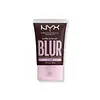NYX Cosmetics Bare With Me Blur Skin Tint Foundation Versus Flower Beauty by Drew Light Illusion Liquid Foundation
What's inside
What's inside
 Key Ingredients
Key Ingredients

No key ingredients
 Benefits
Benefits

 Concerns
Concerns

 Ingredients Side-by-side
Ingredients Side-by-side

Dimethicone
EmollientWater
Skin ConditioningIsododecane
EmollientGlycerin
HumectantSilica
AbrasivePEG-9 Polydimethylsiloxyethyl Dimethicone
EmulsifyingPropylene Glycol
HumectantDisteardimonium Hectorite
StabilisingDimethicone Crosspolymer
Emulsion StabilisingPEG-10 Dimethicone
Skin ConditioningCetyl PEG/PPG-10/1 Dimethicone
EmulsifyingPhenoxyethanol
PreservativeSodium Chloride
MaskingPolyglyceryl-4 Isostearate
EmulsifyingCaprylyl Glycol
EmollientDisodium Stearoyl Glutamate
CleansingEthylhexylglycerin
Skin ConditioningAluminum Hydroxide
EmollientButylene Glycol
HumectantCamellia Sinensis Leaf Extract
AntimicrobialNiacinamide
SmoothingSodium Hyaluronate
HumectantTocopherol
AntioxidantPentaerythrityl Tetra-Di-T-Butyl Hydroxyhydrocinnamate
AntioxidantDimethicone, Water, Isododecane, Glycerin, Silica, PEG-9 Polydimethylsiloxyethyl Dimethicone, Propylene Glycol, Disteardimonium Hectorite, Dimethicone Crosspolymer, PEG-10 Dimethicone, Cetyl PEG/PPG-10/1 Dimethicone, Phenoxyethanol, Sodium Chloride, Polyglyceryl-4 Isostearate, Caprylyl Glycol, Disodium Stearoyl Glutamate, Ethylhexylglycerin, Aluminum Hydroxide, Butylene Glycol, Camellia Sinensis Leaf Extract, Niacinamide, Sodium Hyaluronate, Tocopherol, Pentaerythrityl Tetra-Di-T-Butyl Hydroxyhydrocinnamate
Water
Skin ConditioningEthylhexyl Palmitate
EmollientButylene Glycol
HumectantCaprylic/Capric Triglyceride
MaskingButylene Glycol Dicaprylate/Dicaprate
EmollientGlycerin
HumectantEthylhexyl Methoxycinnamate 5%
UV AbsorberTitanium Dioxide 2%
Cosmetic ColorantZinc Oxide 4.9%
Cosmetic ColorantNeopentyl Glycol Diethylhexanoate
EmollientCetyl Ethylhexanoate
EmollientPEG-30 Dipolyhydroxystearate
EmulsifyingPentylene Glycol
Skin ConditioningCetyl PEG/PPG-10/1 Dimethicone
EmulsifyingPolymethyl Methacrylate
PEG-10 Dimethicone
Skin ConditioningCyclopentasiloxane
EmollientPhenoxyethanol
PreservativeMagnesium Sulfate
Sorbitan Isostearate
EmulsifyingBeeswax
Emulsion StabilisingStearalkonium Hectorite
Gel FormingTriethoxycaprylylsilane
Aluminum Hydroxide
EmollientStearic Acid
CleansingDimethicone
EmollientEthylhexylglycerin
Skin ConditioningDisodium EDTA
Iron Oxides
Mica
Cosmetic ColorantWater, Ethylhexyl Palmitate, Butylene Glycol, Caprylic/Capric Triglyceride, Butylene Glycol Dicaprylate/Dicaprate, Glycerin, Ethylhexyl Methoxycinnamate 5%, Titanium Dioxide 2%, Zinc Oxide 4.9%, Neopentyl Glycol Diethylhexanoate, Cetyl Ethylhexanoate, PEG-30 Dipolyhydroxystearate, Pentylene Glycol, Cetyl PEG/PPG-10/1 Dimethicone, Polymethyl Methacrylate, PEG-10 Dimethicone, Cyclopentasiloxane, Phenoxyethanol, Magnesium Sulfate, Sorbitan Isostearate, Beeswax, Stearalkonium Hectorite, Triethoxycaprylylsilane, Aluminum Hydroxide, Stearic Acid, Dimethicone, Ethylhexylglycerin, Disodium EDTA, Iron Oxides, Mica
 Reviews
Reviews

Ingredients Explained
These ingredients are found in both products.
Ingredients higher up in an ingredient list are typically present in a larger amount.
Aluminum Hydroxide is a form of aluminum. It can be naturally found in nature as the mineral gibbsite. In cosmetics, Aluminum Hydroxide is used as a colorant, pH adjuster, and absorbent.
As a colorant, Aluminum Hydroxide may add opacity, or reduce the transparency. Aluminum hydroxide is contains both basic and acidic properties.
According to manufacturers, this ingredient is an emollient and humectant. This means it helps hydrate the skin.
In medicine, this ingredient is used to help relieve heartburn and help heal ulcers.
There is currently no credible scientific evidence linking aluminum hydroxide in cosmetics to increased cancer risk.
Major health organizations allow the use of aluminum hydroxide in personal care products and have not flagged it as a carcinogenic risk at typical usage levels.
Learn more about Aluminum HydroxideButylene Glycol (or BG) is used within cosmetic products for a few different reasons:
Overall, Butylene Glycol is a safe and well-rounded ingredient that works well with other ingredients.
Though this ingredient works well with most skin types, some people with sensitive skin may experience a reaction such as allergic rashes, closed comedones, or itchiness.
Learn more about Butylene GlycolThis ingredient is a high molecular weight silicone. It has emulsifying and skin conditioning properties.
Dimethicone is a type of synthetic silicone created from natural materials such as quartz.
What it does:
Dimethicone comes in different viscosities:
Depending on the viscosity, dimethicone has different properties.
Ingredients lists don't always show which type is used, so we recommend reaching out to the brand if you have questions about the viscosity.
This ingredient is unlikely to cause irritation because it does not get absorbed into skin. However, people with silicone allergies should be careful about using this ingredient.
Note: Dimethicone may contribute to pilling. This is because it is not oil or water soluble, so pilling may occur when layered with products. When mixed with heavy oils in a formula, the outcome is also quite greasy.
Learn more about DimethiconeEthylhexylglycerin (we can't pronounce this either) is commonly used as a preservative and skin softener. It is derived from glyceryl.
You might see Ethylhexylglycerin often paired with other preservatives such as phenoxyethanol. Ethylhexylglycerin has been found to increase the effectiveness of these other preservatives.
Glycerin is already naturally found in your skin. It helps moisturize and protect your skin.
A study from 2016 found glycerin to be more effective as a humectant than AHAs and hyaluronic acid.
As a humectant, it helps the skin stay hydrated by pulling moisture to your skin. The low molecular weight of glycerin allows it to pull moisture into the deeper layers of your skin.
Hydrated skin improves your skin barrier; Your skin barrier helps protect against irritants and bacteria.
Glycerin has also been found to have antimicrobial and antiviral properties. Due to these properties, glycerin is often used in wound and burn treatments.
In cosmetics, glycerin is usually derived from plants such as soybean or palm. However, it can also be sourced from animals, such as tallow or animal fat.
This ingredient is organic, colorless, odorless, and non-toxic.
Glycerin is the name for this ingredient in American English. British English uses Glycerol/Glycerine.
Learn more about GlycerinPeg-10 Dimethicone is silicone with conditioner and emulsifier properties. It mostly acts as an emollient in skincare and and humectant in haircare.
According to the manufacturer, acidic formulations decrease the stability of this ingredient. It works best in neutral or near neutral formulations.
Phenoxyethanol is a preservative that has germicide, antimicrobial, and aromatic properties. Studies show that phenoxyethanol can prevent microbial growth. By itself, it has a scent that is similar to that of a rose.
It's often used in formulations along with Caprylyl Glycol to preserve the shelf life of products.
Water. It's the most common cosmetic ingredient of all. You'll usually see it at the top of ingredient lists, meaning that it makes up the largest part of the product.
So why is it so popular? Water most often acts as a solvent - this means that it helps dissolve other ingredients into the formulation.
You'll also recognize water as that liquid we all need to stay alive. If you see this, drink a glass of water. Stay hydrated!
Learn more about Water